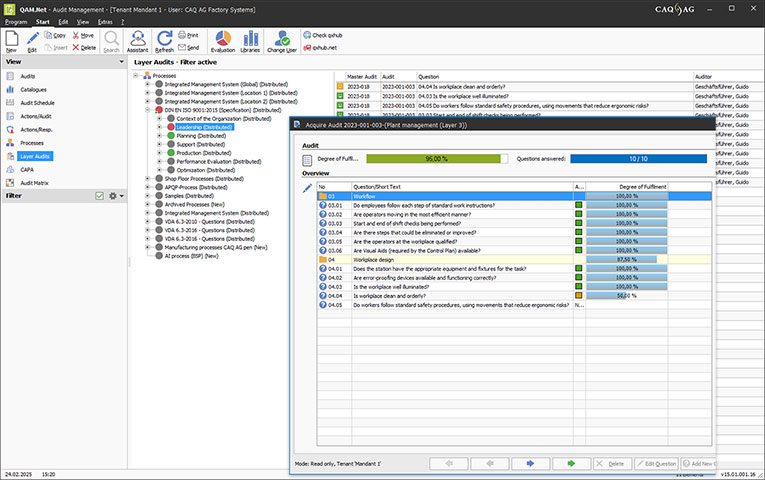LPA Software
When used as an LPA software, QAM.Net supports you in establishing Layered Process Audits (LPAs) in the company and transforming audits from a tiresome one-time event into a meaningful routine task. Create a dynamic audit system with this software and establish a culture of quality in your company.
Some corporate quality systems in manufacturing companies focus only on product inspections and merely checking the output of production processes. Whilst this is obviously a necessary action, it does not go far enough. Companies should not stop at conducting audits and inspections revolving around the product itself, but also regularly check all processes in the company using process audits.
 Layered process audit in the audit management software QAM.Net
Layered process audit in the audit management software QAM.Net
Keeping an Eye on Processes: From Process Audits to Layered Process Audits
The purpose of process audits is to observe and validate the manufacturing process, rather than simply checking the end results. These audits examine how products are manufactured and services are delivered and can therefore detect faulty processes much earlier, helping to highlight deficiencies before they become serious problems. Layered Process Audits (LPAs) are a specific variation of process auditing that is most common in the automotive sector. The main difference between a traditional process audit and a layered process audit (LPA) is foremost who in the company participates in the overall auditing process.
LPA: All Aboard
In contrast to traditional process audits, LPAs are not limited to the quality management team of a company, but aim to include as many different departments, levels, and employees as possible. Whilst shop floor managers conduct recurring process audits in their own individual areas of responsibility, more high-level managers conduct the same audits less frequently, but in a broader range of areas. These audits usually deliver corrective and preventive actions, which are executed either already during the audit or directly after it has been performed.
Audits in an LPA system are performed at a predetermined frequency, depending on the layer they are featured at in the company’s overall auditing plan. By having multiple layers of the same audit, an LPA system helps to ensure that audits are performed correctly, as auditors are technically monitoring the audit performance of each other. Ultimately, by involving as many departments, employees, and areas of management as possible, the company establishes a culture that ensures and reflects the fact that quality is important to every individual in the company.
Why LPA Software?
Apart from facilitating the initial design and monitoring of an LPA system, an enterprise-wide Audit Management Software provides support specifically in terms of responsiveness and speed of information transfer. For this reason, and not least in order to be able to reach all employees, LPA Software should ideally have web apps for decentralized audit recording in the sense of overall communication capability. Equipped with apps, LPA Software in conjunction with other modules of a holistic Quality Management Software enables corrective actions to be assigned and tracked through to completion - closing the quality loop. This information transparency means that LPA Software can also highlight problem areas in a targeted manner and help management to identify opportunities for improvement, as all the necessary information is collected and made available for subsequent analysis.